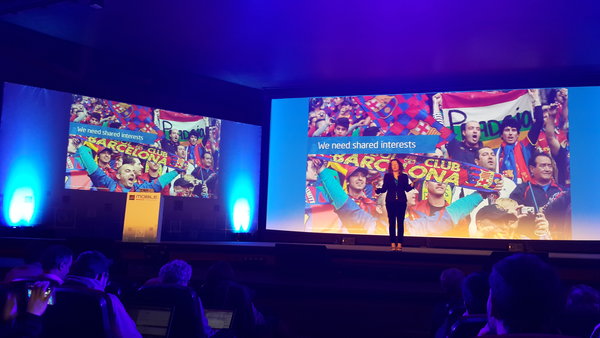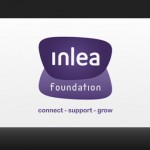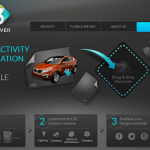MWC 2014 ended about a week ago and I thought it’s appropriate to share some things that I saw, heard, and read during this event. It was also my fourth year attending this event, always with high expectations. To the point; although it’s common, specially on this type of event, to discuss which is the best mobile device launched by this or that manufacturer or which are the most promising apps for this starting year, my personal interest is to talk about technological trends in the mobile industry and some other interesting things, at least for me, such as which is the state of the Telco APIs, what happen in the OTT-Telco relationship, and also to comment briefly the Dr. Genevieve’s talk from Intel. However, I would like to say that my post at first sight doesn’t have a defined storyline, because my initial idea was just to mention noteworthy topics without having in mind a special order; though all these topics are part of the mobile communications ecosystem and therefore these are related each other somehow.
I just attended a couple of talks and main exhibition but unfortunately I was unable to attend Mark Zuckenberg’s talk in situ. It’s clear that his presence was the most expected thanks to WhatsApp acquisition by Facebook for USD 19 billions but the key point in my view was to know, among other things, which is the new scenario opens in the fight for supremacy of the instant messaging and specially of the mobile voice calls at the global level, once WhatsApp announced in Q2 of this year will include this new last feature for free. It’s true that apps such as Line or Viber already have voice services but Whatsapp is a giant and in this sense, Jan Koum, WhatsApp CEO, he talked about figures: “To date, we have 330 million daily and 465 million monthly active users. We also have detected an increase of 15 million on the number of users when Facebook acquisition was known”. It suggests that in the upcoming months there will be significant movements in relation to OTT-Telco battle, which will be fought not only here but also in other scenarios such as Netflix vs US Telcos (Who should pay for the upgrade of the network?, network neutrality obsolete?), but it’s another interesting story.
An inspirational Talk: Dr. Genevieve Bell from Intel
I went to the Dr. Bell’s talk with many expectations. I wanted to know her vision about technology today and I wasn’t disappointed. Let’s see, all she said is a bit expected or say obvious, she doesn’t reinvent the wheel but her vision is valuable because as anthropologist and director of Intel Corporation’s Interaction and Experience Research, presented a clear and inspiring idea about which things we should keep in mind when develop applications or services currently. I want to remember this talk was given within the scope of WIPjam workshop where audience is typically technical.
At times, apps developers and designers tend to focus on technology forgetting the real needs, this is, “technology must grasp human nature” in order to have success apps. In this sense, she explained that, despite of passage of time, there are 5 things that haven’t changed in human behaviour: “1) We need friends and family, 2) We need share interest, 3) We need a big picture 4) We need objects that talk for us and 5) We need our secrets”. So, with this in mind, it’s logical to think the reasons why social networks have been successful. On the other hand she also mentioned 5 things that technology is reshaping the human behaviour and where new questions arise: “1) How to guard our reputations?, 2) How to be surprised or bored?, 3) How to be different?, 4) How to have a sense of time?, and 5) How to be forgotten?”.
It’s true that all these are generic issues which have multiple implications such as privacy and anonymity, but it also points to the fact that human being “wants to be human not digital” and this must be considered as a starting point in the development of new services and applications.
Coming back to MWC…
Telco APIs
Telco API workshop was interesting in general terms: different visions and one common goal: to provide a flexible and robust APIs ecosystem that allow to Telcos develop solutions more quickly under the premise of interoperability, scalability and security overall. Telcos want to bridge the gap with OTT trying to recover territory in some businesses as instant messaging and proposing advanced solutions in the area of mobile calls and video streaming by means of RCS (Rich Communications) suite. For this, GSMA, a global association of mobile operators, want to give a new boost to solutions as Joyn (app for chat, voice calls, file sharing, etc) which to date hasn’t given the expected results. On the other hand WebRTC, a multimedia framework focused on real-time communications over web browsers, is gaining momentum from last months. It’s doesn’t clear that WebRTC is going to be fully embraced by Telcos, but sure they are planning some synergies with its RCS, at least this I perceived in MWC.
For all is known the slowness in innovation of the operators either due to internal bureaucracy of organizations, interoperability and integration issues or standardization delay, but according to different speakers in this workshop, Telcos are aware of this lack and, as it would expect are working with manufacturers on solutions associated to RCS and VoLTE (Voice over LTE). Moreover, new business models are need because with free competitor solution such as Line, Viber or soon Whatsapp in voice calls, they cannot charge for services such as SMS or perhaps mobile calls inclusive. Although it’s true that there is a big difference in the targeted markets. At least I don’t know a big company that uses Whatsapp for its corporative communications for security aspects and on the other hand when you pay for a service you demand quality, security, etc and therefore Telcos play in another league (for now). In any case, Telco are convinced to create a robust Telco API ecosystem that allows them to take advantage over OTTs.
Some interesting companies present in Telco API workshop were: Apigee, Aepona and Solaiemes (from Spain). In general Telco APIs are focused on improving interoperability, integration, monetization, service creation, among other things and can be grouped as follows: Communications (Voice, Messaging, Conferencing), Commerce (Payment, Settlement, Refund, and Identity), Context (Location, Presence, Profile, Device Type), and Control (QoS, Data Connection Profile, Policy, and Security & Trust). For more detail, I also recommend to read about OneAPI, a global GSMA initiative to provide APIs that enable applications to exploit mobile network capabilities.
Big Data and SDN
From my recent posts about Big Data and SDN nothing has changed in my appraisal. So, I just would like to add some ideas to complement the information given previously. I can see that Big Data and SDN/NFV are on track to become key elements to support OSS (Operational Support Systems) and BSS (Business Support Systems) within Telcos. OSS and BSS are considered main assets whose importance in the current and future business is now unquestionable. For example, churn is a challenge problem for the Telcos whose predictive analysis is key in order to avoid customer attrition. Another example, no without controversy, is the sale of anonymized and aggregate data. Here, telco thanks to information gather from cellular cells indicate areas where an enterprise can install this or that type of business and other demographic data. Also, I could see some interesting solutions given by SAP (Hana platform) or Hitachi Data System. Unfortunately, I also was unable to attend to keynote panel “Up to Close and Personal: The Power of Big Data” where representatives from Alcatel-Lucent, EMC and SK Planet debated about the convergence of ubiquitous connectivity, cloud computing and Big Data analytics. I guess they talked about these issues and challenges in the industry. It’s a new world to explore.
Although SDN and NFV are solutions, say, mainly focus on data centers and backbone networks (also SDN WAN), it seems that mobile networks neither have escaped to “the charm” of SDN. It’s proposed to use the SDN capabilities in centralization/abstraction of the control plane in order to apply traffic optimization functions (also for radio resources). From technical point of view, this is very interesting because, as we all know, mobile traffic is increasing and Telcos and researchers are searching practical solutions to mitigate some capacity problems and SDN and NFV could be a real alternative. In MWC, HP also launched its Open NFV strategy for telcos with the purpose to help them in the acceleration of the innovation and generation of new services.
Hetnets, Backhaul, Small Cells and Hotspot 2.0
MWC is the great meeting point where Telcos (mainly Mobile Carriers) and manufacturers can discuss their network needs and to present their services and products respectively. As in 2013, many well-known concepts were heard again in the talks, halls, and booths of the exhibition. However a key idea always is present in the environment: How to provide better bandwidth (network capacity) and QoS under an increasing traffic or radio spectrum depletion. In this sense, many people are currently talking about “mobile data crunch” which is indicative that it’s necessary to search possible solutions. Small Cell, for example, is a solution to improve the mobile service coverage and so to expand network capacity for indoor and outdoor locations. This solution can be used in complementary way to macro cell or to cover a new zone faster and over licensed or unlicensed spectrum. Depending on the needs there are many options in choosing a small cell: pico cells, femto cells, etc.
On the other hand, Wifi networks are again seeing the light of day, thanks to Hotspot 2.0, which is a set of protocols to enable cellular-like roaming (i.e. automatic Wifi authentication and connection). This allows that Wifi is a real alternative to improve coverage and many Telcos is already exploring this solution or inclusive planning alliances with established Wifi operators like Fon or Boingo.
All this brings us another recurrent concept: Hetnet, this is, heterogeneous network but focus on the use of multiple types of access nodes in a wireless network, i.e. integration and interoperability for traditional macro cells, small cells and Wifi. And now, How can we connect all these type of access points to backbone? Well, the answer is simple: through Mobile Backhaul, which is a part of mobile network that interconnect cell towers with core network. In MWC were presented different solutions: wired and wireless, based on Ethernet IP/MPLS, Microwave, with line-of-sight (LoS), near line-of-sight (nLoS), and non-line-of sight (NLoS), etc. It’s is an area very active and broad but in this post isn’t worth to enter into too details.
Wearables and Digital Life
Finally, I would like to comment two ideas that were highlighted in MWC 2014. First, “wearables”, a buzzword that refers to small electronic devices based on sensors (body-borne computing) that may be worn under, with or on top of clothing, i.e. watches, wristbands, glasses and other fitness sensors. Many companies presented their products that will set trend this 2014: Fitbit, Smartband (Sony), Gear2/Neo (Samsung), etc, etc. According to Dr. Bell, wearable computing has much potential because also fit with the human nature, although all this is an early stage (even though, it’s a old idea), it’s clear that technology as said she, “is changing some of our behaviours and preferences”.
Digital Life is another buzzword. Basically is commercial name given to an advanced home automation system by ATT. I suppose Digital Life, as name or concept, is related to research from MIT about rethinking of the human-computer interactive experience. Well, ATT solution basically uses Internet of things (IoT), Augmented Reality (AR) and many other technologies that “supposedly” will make our life most secure, comfortable and easy at home. I mention all this because “wearables” and “Digital Life” are two old concepts that today again are gaining strength and it’s expected are trends in the next months or years. Many things I have left out (e.g. LTE evolution, VoLTE, 5G, Internet of Things, 4YFN initiative, some local startups, and many etc.). Perhaps in an upcoming post I come back to comment some of the topics.
Image credit: Mobile World Congress Barcelona via Shutterstock








Leave a Reply